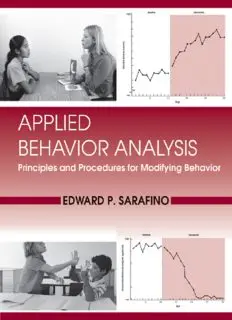Table Of ContentAPPLIED BEHAVIOR
ANALYSIS
Principles and Procedures
for Modifying Behavior
APPLIED BEHAVIOR
ANALYSIS
Principles and Procedures
for Modifying Behavior
Edward P. Sarafino
The College of New Jersey
JOHNWILEY&SONS,INC.
VICEPRESIDENT&EXECUTIVEPUBLISHER JayO’Callaghan
EXECUTIVEEDITOR ChristopherJohnson
SENIORACQUISITIONSEDITOR RobertJohnston
ASSOCIATEEDITOR EileenMcKeever
EDITORIALASSISTANT MauraGilligan
SENIORMARKETINGMANAGER DanielleHagey
SENIORPHOTOEDITOR JenniferMacMillan
PHOTORESEARCHER ElleWagner
SENIORMEDIAEDITOR LynnPearlman
SENIORPRODUCTIONMANAGER JanisSoo
ASSOCIATEPRODUCTIONMANAGER JoycePoh
ASSISTANTPRODUCTIONEDITOR YeeLynSong
COVERDESIGNER SengPingNgieng
COVERPHOTOCREDIT MichaelNewman/PhotoEdit(topphoto)
Relaximages/Cultura/GettyImages(bottomphoto)
Thisbookwassetin9.5/11.5NovaresebyLaserwordsPrivateLimitedandprintedandboundbyCourierWestford.Thecoverwas
printedbyCourierWestford.
Thisbookisprintedonacid-freepaper.
Foundedin1807,JohnWiley&Sons,Inc.hasbeenavaluedsourceofknowledgeandunderstandingformorethan200years,
helpingpeoplearoundtheworldmeettheirneedsandfulfilltheiraspirations.Ourcompanyisbuiltonafoundationofprinciples
thatincluderesponsibilitytothecommunitiesweserveandwhereweliveandwork.In2008,welaunchedaCorporateCitizenship
Initiative,aglobalefforttoaddresstheenvironmental,social,economic,andethicalchallengeswefaceinourbusiness.Amongthe
issuesweareaddressingarecarbonimpact,paperspecificationsandprocurement,ethicalconductwithinourbusinessandamong
ourvendors,andcommunityandcharitablesupport.Formoreinformation,pleasevisitourwebsite:www.wiley.com/go/citizenship.
Copyright©2012JohnWiley&Sons,Inc.Allrightsreserved.Nopartofthispublicationmaybereproduced,storedinaretrieval
systemortransmittedinanyformorbyanymeans,electronic,mechanical,photocopying,recording,scanningorotherwise,except
aspermittedunderSections107or108ofthe1976UnitedStatesCopyrightAct,withouteitherthepriorwrittenpermissionofthe
Publisher,orauthorizationthroughpaymentoftheappropriateper-copyfeetotheCopyrightClearanceCenter,Inc.222Rosewood
Drive,Danvers,MA01923,websitewww.copyright.com.RequeststothePublisherforpermissionshouldbeaddressedtothe
PermissionsDepartment,JohnWiley&Sons,Inc.,111RiverStreet,Hoboken,NJ07030-5774,(201)748-6011,fax(201)748-6008,
websitehttp://www.wiley.com/go/permissions.
Evaluationcopiesareprovidedtoqualifiedacademicsandprofessionalsforreviewpurposesonly,foruseintheircoursesduring
thenextacademicyear.Thesecopiesarelicensedandmaynotbesoldortransferredtoathirdparty.Uponcompletionofthereview
period,pleasereturntheevaluationcopytoWiley.Returninstructionsandafreeofchargereturnmailinglabelareavailableat
www.wiley.com/go/returnlabel.Ifyouhavechosentoadoptthistextbookforuseinyourcourse,pleaseacceptthisbookasyour
complimentarydeskcopy.OutsideoftheUnitedStates,pleasecontactyourlocalsalesrepresentative
LibraryofCongressCataloging-in-PublicationData
Sarafino,EdwardP.
Appliedbehavioranalysis:principlesandproceduresformodifyingbehavior/EdwardP.Sarafino.
p.cm.
Includesbibliographicalreferencesandindex.
ISBN978-0-470-57152-1(pbk.:acidfreepaper)
1.Behaviormodification.I.Title.
BF637.B4S2682012
153.8’5—dc23
2011025717
PrintedintheUnitedStatesofAmerica
10987654321
To Jim
ABOUT THE AUTHOR
EdwardP.SarafinoreceivedhisPhDfromthe
UniversityofColoradoandimmediatelybeganhis
32-yearaffiliationwiththeDepartmentofPsychology
atTheCollegeofNewJersey.Hisscholarship
continuestocombineareasofhealthandbehavioral
psychology,particularlyinhisstudyofasthma.In
additiontohavingpublisheddozensofresearch
articlesandchapters,heistheauthorofsixbooks.
HeisamemberofDivision25(TheExperimental
AnalysisofBehavior)oftheAmericanPsychological
AssociationandisafellowofDivision38(Health
Psychology).Heservedasanofficer(secretary)of
Division38,andhasbeenamemberofseveral
committeesoftheDivisionandtheSocietyof
BehavioralMedicine.Whenheisnotworking,he
enjoysbeingwithfamilyandfriends,traveling,hiking
andotheroutdooractivities,andgoingtocultural
events,especiallymusicandvisualarts.
TO CONTACT THE AUTHOR
Iwouldbepleasedtoreceivecommentsand futureeditions.Youmaycontactmebye-mailat
suggestionsaboutthisbookfromstudentsand sarafino@tcnj.edu.
instructorssothatImayconsiderthoseideasfor EdwardP.Sarafino
PREFACE
Psychologistshavediscoveredagreatdealofinformationabouthumanbehavior,butnotalloftheknowledge
wehavegainedcanbeappliedtoimprovethewaypeoplebehaveandfunctionintheireverydaylives.Thefieldof
appliedbehavioranalysisisuniqueinthisrespect,havingdevelopedarichandvariedsystemofmethods,based
on established principles of learning, that have been applied effectively toward improving people’s behavior.
Applications of behavior change techniques have been successful in almost all areas of psychology and in a
widevarietyofsettings.
My goal in writing this book has been to create a clear and engaging teachinginstrument that describes
waystoanalyzeone’sownspecificbehaviorsintermsofthefactorsthatleadtoandmaintainthemandways
tomanagethosefactorstoimprovethebehaviors.Ihavedrawnonresearch,theory,andmyownandstudents’
experiences to explain and provide examples of the concepts and methods of applied behavior analysis in a
comprehensivetext.Thetextisappropriateforseveralcourses,especiallythosethatfocusontopicsinapplied
behavioranalysis,behaviormodification,behaviortherapy,andpsychologyoflearning.Thesecoursesarelikelytobeoffered
indepartmentsofpsychology,specialeducation,andspeechpathology.
Two general features of the students’ educational backgrounds shaped my writing. First, students who
use this book are likely to come from a variety of fields. I have tried to make the material interesting and
relevanttostudentsfromallfieldsbydescribingapplicationsinpsychology,education,counseling,nursing,and
physicaltherapy.Second,studentswhousethisbookarelikelytovaryintheiracademiclevelandpreparation.
AlthoughIaimedtomakethecontentappropriateforupper-divisionstudents,especiallyjuniors,Iwrotewith
astraightforwardwritingstyletomakethecontentaccessibletomostsophomores,includingthosewho’venot
takenanintroductorypsychologycourse.
Thefieldofappliedbehavioranalysisisenormouslyexciting,partlybecauseofitsrelevancetothecurrent
livesofthosewhostudyitaswellastotheindividualsthestudentsknoworwillworkwithinthefuture.The
fieldisalsoexcitingbecauseitsknowledgeisappliedinsomanydifferentsettingsandcanbeusedtochange
one’sown behavior.Creatingabookthatiscomprehensiveinitscoverageof behaviorchangeprinciplesand
uptodateineachareaofapplicationisachallenge.Iconsultedthousandsofarticlesandbooksinwritingthis
text,whichcitesmorethan1,000references,overone-fifthofwhichwerepublishedinthelast10years.
OBJECTIVES AND DISTINCTIVE FEATURES OF THIS BOOK
Severalimportantobjectivesguidedthecontentandorganizationofmywriting.Thistextwasdesignedto:
• Cover a large majority of tasks or concepts that the Behavior Analyst Certification Board (www.bacb.com) has
identifiedasthefield’sessentialcontentthatshouldbemasteredbyallbehavioranalysts.
• Provideanunderstandingofthefundamentaltechniquesofappliedbehavioranalysisbypresentingitsconcepts
andproceduresinalogicalsequenceandgivingcleardefinitionsandexamplesofeachtechnique.
• Teachstudentshowtopinpointanddefinethebehaviortobechangedandhowaresponseisdeterminedbyits
antecedentsandconsequences.
• Teachusable,practicalskillsbyspecificallystatingthepurposeofeachtechnique,describinghowitiscarriedout,
andpresentingguidelinesandtipstomaximizeitseffectiveness.
• Describewhyandhowtodesignaprogramtochangeabehavioraldeficitorexcessbyconductingafunctional
assessment and then selecting and combining techniques that can be directed at the behavior itself and its
antecedentsandconsequences.
vii
viii Preface
• Illustratewhyandhowtocollectandanalyzedata.
• Providestudentswithahandbooktohelpthemdesignandconductinterventionstomodifybehaviorswhenthey
enterprofessionalcareers.
Itismyhopethatthistextwillserveasahandbookforstudentswhobecomebehavioranalyststodesignand
conductinterventionstochangeclients’behaviors.
Several features of this book and its companion website are seldom found in texts in applied behavior
analysisorbehaviormodification.Thisbookhas:
• CaseStudyboxedmaterialinalmostallchapters,describinginsomedetailtheapplicationofbehavioranalysis
methodswithspecificindividualstomakebehaviorproblemsandtheprocedurestochangethemconcrete.
• Close-Up boxed material in almost all chapters that presents theoretical or controversial issues and in-depth
conceptualtopics.
• ConceptCheckboxes,generallytwoperchapter,toteststudents’basicgraspoftheconceptsandproceduresin
theprecedingsections.Someofthequestionsare‘‘criticalthinking’’itemsthataskstudentstostateanexample
fromtheirreadingortheirownlives.Answersaregivenattheendofthechapter.
• Listsofkeyterms(whicharedefinedinthetextandtheglossary)andessay-typereviewquestions.
• Listsoftipsinabouthalfofthechaptersonhowtoapplyspecifictechniques.
• Awholechapterwithdetailedreasons,procedures,anddataformsfordoingafunctionalassessmentofabehavior,
enablingstudentstodefineabehavioranddetermineitsantecedentsandconsequences.Thismaterialincludes
howtointerpretdatafromafunctionalanalysiswithgraphedexamples.
• Materialshowingstudentshowtographdataanddoagraphicanalysis.
• Chaptersonbiofeedback,tokeneconomies,andrule-governedandverbalbehavior.
• Achapterthatdescribeshowtogetadditionaltrainingandcertificationinappliedbehavioranalysis.
• Anonlinestudyguideonitscompanionwebsite.
HOW THIS BOOK IS ORGANIZED
I organized the chapters in this book so that the material within and across chapters occurs in an orderly
sequence, establishing each conceptual foundation on which to add new information and principles. The
chapters and material within them are organized to build upon relatively simple concepts and techniques
towardincreasinglycomplexandspecializedmethods.Thebookisdividedinto28relativelyshortchapters,each
withasufficientandmanageableamountofinformation.Thechaptersaredividedintothefollowingsevenparts:
• PartI:IntroducingAppliedBehaviorAnalysis.Chapters1to4describebasicbehavioralconceptsandprocesses,how
to identify and assess target behaviors, graphic analysis and research methods, and how principles of applied
behavioranalysishavebeenappliedeffectivelytoimproveawidevarietyofbehaviorsinmanysettings.
• PartII:BasicOperantPrinciples.Chapter5discussespositiveandnegativereinforcementanddescribestheirmany
types with examples from everyday life. Chapters 6 and 7 cover the processes and characteristics of extinction
and punishment, describingtypes of and concerns about positive and negative punishers.Chapter 8 discusses
theroleofantecedentsandstimuluscontrolinproducingspecificbehaviors.AndChapter9discussesmotivating
operations.
• Part III: Methods to Establish New Operant Behaviors. Chapters 10 to 12 discuss the process of shaping, methods for
shortcutstimuluscontrol(promptingandfading),andbehavioralchains.
• Part IV: Methods for Modifying Operant Behaviors. Chapter 13 describes the need and procedures for functional
assessments. Chapter 14 covers ways to manage antecedents. Chapters 15 and 16 discuss how to increase a
behavior with basic and advanced reinforcement techniques. Chapters 17 to 19 focus on methods to decrease
problembehaviors.AndChapter20coverswaystomaintainimprovedoperantbehaviors.

